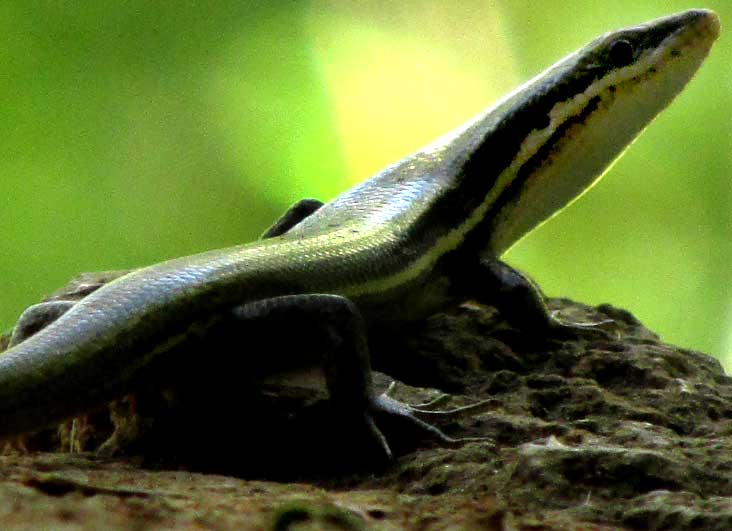Excerpts from Jim Conrad's
Naturalist Newsletter
from the August 23, 2018 Newsletter issued from Rancho Regenesis in the woods ±4kms west of Ek Balam Ruins; elevation ~40m (~130 ft), N~20.876°, W~88.170°; central Yucatán, MÉXICO
MAYAN SKINK
While reading on the hut's porch, movement on a nearby rock caught my eye, the camera was near, so I got the picture shown below:

The 10inch long (25cm), slender little lizard was moving fast, poking his nose into every hole and beneath every leaf, so I got only that one picture. A blown-up part of that image better showing the creature's front end is seen below:

Bearing such a well defined white line along the side, that passes beneath the ear hole and the eye, and with the lizard's unusually slender form, it was easy to match our picture with one in Jonathan Campbell's Amphibians and Reptiles of Northern Guatemala, the Yucatán, and Belize, identified as the Viviparous Skink, Mabuya brachypoda*.
*UPDATE: Later the species Mabuya brachypoda was assigned to a different genus, with our skink's name becoming Marisora brachypoda. Then in 2020 the study by James McCranie and others entitled "A morphological and molecular revision of lizards of the genus Marisora Hedges & Conn (Squamata: Mabuyidae) from Central America and Mexico, with descriptions of four new species," found that the species Marisora brachypoda, as then recognized, was composed of more than one taxon. Skinks in our area were described as a new species, MARISORA LINEOLA, in English referred to as the Mayan Skink.
Just by looking at our pictures, I can't see the difference between Marisora brachypoda, which now is described as distributed from southern Guatemala on the Pacific side south into Costa Rica, and our Marisora lineola, occurring throughout the the Yucatan Peninsula, western Chiapas, Belize and most of Guatemala. However, the above-mentioned study reports the genetic evidence that the species are different. Also, on The Reptile Database page for the species, I read that "Marisora lineola is most easily distinguished from M. brachypoda by having one or two dark brown or black dorsolateral body lines or dark brown dashes or spots suggesting lines (versus those dark marks absent or indistinct in M. brachypoda)."